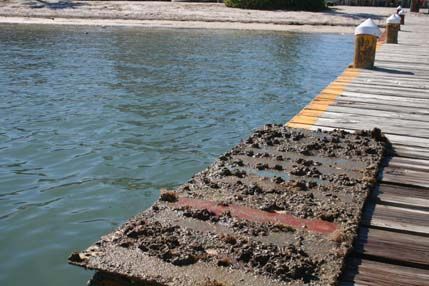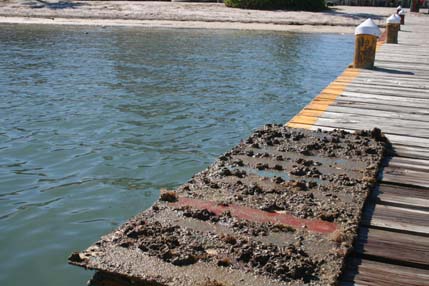
There are very few times when the door to my office is closed. Bottom paint rating tabulation time is one of them. For the past week Ive been poring over bottom paint data collected earlier this month: three Excel tables representing more than 300 data points. Although mammoth data tables are not what drew me into this business, the bottom paint program is still one of my favorite projects. Ive spent enough time scrubbing, scraping, and painting to appreciate the importance of what we do.
This is now my 13th season overseeing our semi-annual testing program, and Im always amazed at how no two seasons deliver the same results. Nevertheless, over the years, some consistent winners have emerged, and well be exploring this in more detail next month when we release our spring 2012 bottom paint test results. This month, I just want to share a few pictures and a bit of insight from our recent round of bottom testing.
For the first time in several years, we have three active sets of panels in the water at the Sarasota Sailing Squadron on Sarasota Bay-a 30-month-old panel, a 14-month-old panel, and a 4-month-old panel.
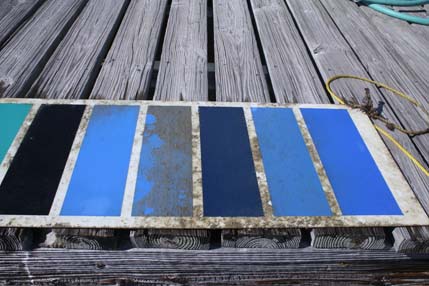
The newest panel, pictured above, has only been in the water four months, and you can see almost all of them are clean-as they should be. Keep in mind that all but a few of these paints are new, copper-free paints designed to meet new restrictions pending in California and slated to take effect in Washington. Many of them include a new biocide called Econea, which according to paint makers is less harmful to the environment than other pesticides and biocides that go into paints.
Youll notice one blue panel, fourth from the right, has about an 80-percent coating of slime. That is Sea Hawks new Smart Solutions, a paint that we will be applying to one of our test boats Skimmer, a 25-foot Cape Dory that Managing Editor Ann Key is helping prep and paint as I write this blog. (I would be helping scrub and paint the hull myself were it not for this important blog post – which, as I review my notes and photos, will clearly require most of the morning.) This is the only paint in our test that has no metal additives, no zinc pyrithione (ZPT), and no copper. Its only listed active ingredient is Econea, which reacts with the water to help create a thin slick film that prevents growth from taking hold.
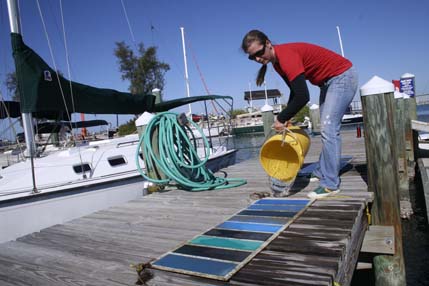
At first glance, the results are not so encouraging. Particularly compared to the adjacent panels that are almost clean. But after Ann sluices down the panel (above), you get a clearer picture of how easily the slime comes off. The biofilm is effectively lifting off the paint in whole sheets.

The close-up photo above gives a clearer view of this effect. When we dropped the panel in the water, the rest of the slime slid right off. In my view, it is still too early to get too excited about Smart Solutions, but it was interesting to watch how it works. Based on what weve seen so far, a person who uses their boat frequently would not have the amount of growth that we have on our panel, and what growth exists will easily wipe away. Other paints, however, are staying cleaner. It will be interesting to compare panel performance over the long haul, as well as on the test boat.
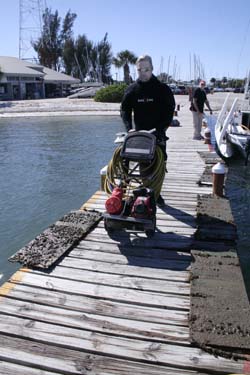
The owner of Skimmer, Mike Collins, is hopeful. He is committed to protecting the environment, which has so far been a boon for his bottom cleaner Dave Mieron (right). Skimmer was one of the guinea pigs for the first batch of Interluxs Pacifica paint, and this began sprouting barnacles after six months in the water. The paint was reformulated almost immediately, and the newest formula, Pacifica Plus, has proven much more effective than that first experimental batch. We generally recommend that readers looking to switch to a more eco-friendly formula wait at least one year-better yet, two years-for the paint to prove itself in the field. Yes, manufacturers do a ton of field testing before launching a new paint, but we’ve seen a few over-hyped eco paints – as well as some conventional formulas – deliver less-than-stellar results.
As copper prices continue to rise and new environmental rules take hold, were going to see a lot more new, and experimental paints-some will do well, and others will not. And its our job to find out which ones make the cut.






























